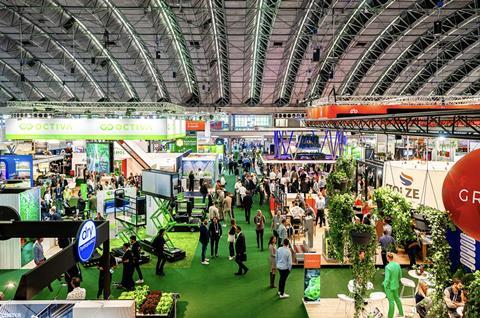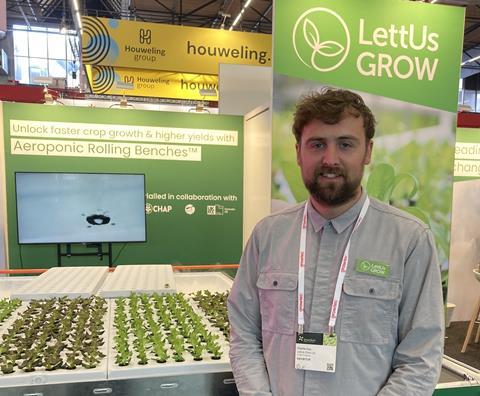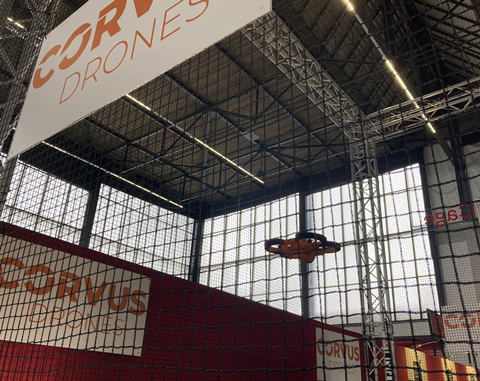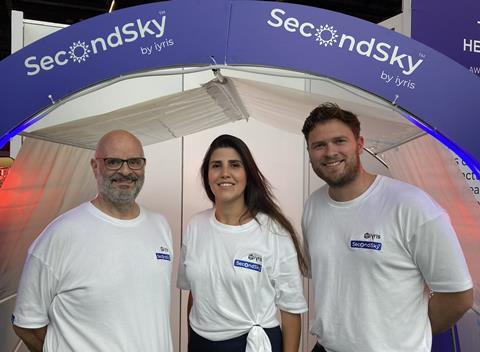On 11-13 June, GreenTech Amsterdam returned to the Dutch capital as technology companies showcased solutions to the most pressing issues facing growers in the horticulture sector, including climate change, rising costs and labour shortages
In June, GreenTech Amsterdam welcomed a total of 510 exhibitors and over 12,200 visitors, 5 per cent more than last year, to the RAI Amsterdam Convention Centre. The event highlighted the future of horticulture, with various stages featuring discussions on topics including ‘Tools and vision in Data and AI’, ‘Greenhouse: The road to a zero footprint?’, and ‘Future vision: A valuable tasty & healthy horticulture’.

Side events included the GreenTech Innovation & Concept Awards. Sustainable solutions provider Koppert picked up the Concept Award for its Digital Assistant, while autonomous growing specialist Blue Radix won the Innovation Award for its Integrated Autonomous Climate & Irrigation Control.
Chairman of the jury for the awards, Egon Janssen, explained the decision. “Artificial Intelligence and data science are developing really fast,” he said. “The winners of the concept and innovation award show that this new technology can help to improve sustainability and reduce labour shortages. The jury was impressed by the scalability of the winning innovation and concept, which can result in a huge impact in the coming years.”
“The Digital Assistant embodies a revolutionary leap forward, surpassing superficial chat bot interaction,” Koppert said. “It provides personalised and context-rich support to growers and consultants for unique IPM challenges, by incorporating vital data from grower’s own crop management system (e.g. climate, pest prevalence, treatments) and our unique knowledge of IPM management and agricultural practices.”
Blue Radix’s Integrated Autonomous Climate & Irrigation Control is a Crop Controller that integrates Autonomous Climate and Irrigation Control. The Crop Controller ensures precise climate and irrigation execution, reducing climate computer work by 80 per cent. “It revolutionises daily greenhouse management, delivering a 5 per cent profit increase and a 7 per cent yield improvement, 10 per cent less water and fertiliser usage, and 15 per cent energy savings,” Blue Radix stated.
A total of 119 countries attended the trade show, according to Mariska Dreschler, director horticulture at GreenTech Global. The top five countries represented were the Netherlands, Germany, South Korea, the UK and Canada.
“The horticulture industry is experiencing a mix of challenges and opportunities,” she said. “The positive energy on the show floor was visible, with numerous new products launched. We received a record of 47 entries for the Innovation & Concept Awards. Striking was that over 45 country official delegations attended to witness the latest developments and gain insights into current trends. Key discussion topics included AI, data, labour solutions, LED technology, and water and energy efficiency.”
LettUs Grow
Among this year’s exhibitors was LettUs Grow, which simulates the perfect soil environment without any soil. “We’ve evaluated our technology with the best people at Wageningen University a few years ago, and since then we’ve been scaling up our manufacturing capabilities, working with partners here in Europe, in the US, and now in India as we start scaling these systems around the world,” said CEO and co-founder Charlie Guy.
“We use aeroponics, which means that we take a nutrient solution and we turn it into a mist, using some fancy electronics and ultrasound technology,” said Guy. “Effectively what we’re doing is shaking that nutrient solution until particles break off into a mist. The plants love it. The roots grow down into that mist, and they can capture much more oxygen for more effective respiration. And that actually means they grow much faster. So we get around 20 per cent yield uplift in leafy greens and herbs.”

The company’s solution is targeted at greenhouse production. “It’s a market that needs to find solutions that can help in reducing water, reducing the impact of growing media and boosting grower productivity, and we offer all three of these,” said Guy. “There are hundreds of different providers of growing media for hydroponics, which is a way of simulating the soil in a way that is less damaging to the soil than traditional farming methods. What we do is take that a step further, and we’ve really reduced the need for growing media. So it’s a very, very low impact way of growing where we’re just feeding the roots directly with what they need.”
Kubo
Kubo announced the construction of the first CO2-negative greenhouse in the world. “We don’t inject any CO2 into the greenhouse,” the company said. “We get it from the natural air. It provides the best results both commercially and environmentally.”
The company has tested the greenhouse on tomatoes, and is now testing it with other vegetables and soft fruit. “We’re taking the outside air and creating enough air movement to ensure the plants can take the CO2 from this air,” said Wouter Kuiper. “Instead of being the polluter, greenhouses become the solution.”
Hortilux
NXTLED is Hortilux’s newest lightest fixture, according to the company’s Lawrence Kemerink, with the first deliveries due in July. “It’s our new model for this year, so we really wanted to promote it at GreenTech,” he said.
With an efficacy of up to 4.1 μmol/J, a power of up to 1400W and an output of over 5500 μmol, the Hortilux NXTLED is the most efficient fixture on the market, according to the company. “It is designed for the big greenhouses, so mainly for growers of products like tomatoes and cucumbers,” he said.
Organifarms
Organifarms’ autonomous robotic strawberry picker appeared once again at GreenTech, but with optimised software and an added cleaner for the gripper to prevent it getting sticky during harvesting.
“The robot senses the ripeness of the fruit to pick at the right time and automatically picks the right weight for the punnets,” said CMO and co-founder Hannah Brown. “The fruit is not touched at all, so this helps with the shelf-life. The machine works 24/7, and picks at a slightly higher rate than a human.”
For now, Organifarms’ customers are based in Europe, mainly in Germany and the Netherlands. “We’re currently focused on strawberries at the moment,” said Brown, “but after scaling the production of this robot, we will start the development of new products, including for other crops.”
Corvus Drones
Corvus Drones are designed for efficient autonomous monitoring of greenhouse-grown salad and flower crops. “Especially in the bigger greenhouses, it’s a lot more affordable than having, say three to four people working full time monitoring the crops,” said the company’s Hugo Klok. “You can to divide a greenhouse into different zones, and schedule the time for the drone to take off and monitor a particular area. Say you schedule the drone for 10am. The drone will take off at that time, fly to the specified zone, scan it, and then fly back to resume charging. Then you can schedule a task for an hour later, for example. It’s a fully autonomous process.”

The company also offers the drone as a service for a monthly fee, including data analysis and reports. “If something breaks, the customer can send it back for a replacement, and when we release a new model, we will update it,” said Klok. “It is being used everywhere, from European countries like Netherlands and Germany to Ecuador and Kenya.”
Octiva
Octiva creates robotic labour automation solutions, including its autonomous robotic strawberry picker and its Kompano leaf-cutting robot. “We have a fully modular system which allows customers to exchange all applications on the same base platform,” said CEO Tom Coen, “which is essential for returns on investment for the grower.”
According to Coen, the aim is to bring autonomy and sustainability together. “Personally, I think cost reduction shouldn’t be the focus in horticulture,” he said. “It’s a margin-controlled business, because what happens is the product becomes cheaper. So our focus is scarcity of labour, quality of labour, consistency of labour. And of course it needs to be competitive cost-wise for the consumer.”
Iyris
Iyris, formerly known as Red Sea, assists growers in harsh environments to boost yields, reduce costs and risk and extend the growing seasons. The company’s main product, developed at King Abdullah University of Science and Technology in Saudi Arabia, seeks to do just that. SecondSky is a transparent cover that blocks excessive heat, reducing stress on the plants.
“This blocks near infrared radiation in the greenhouse,” said Richard Kohn, global marketing director and head of external relations. “So we can save up to 45 per cent of near infrared radiation, depending on the amount of additive. And that will save roughly six to seven degrees before any cooling system in peak temperatures. So that results in less power, less water, less energy put into the greenhouse to maintain it, and we can extend the growing seasons. The quality of the crop is also improved because the transpiration rate on the leaf isn’t as stressed, so the quality increases. You can achieve a threefold yield increase by just changing the roof.”

And it’s not only the hottest places that can make the most of SecondSky. “We’re doing trials in Kent in the UK,” he said. “If you get one intense day in the UK, the plants will get stressed, even just from that one day. So we’ve actually seen some really positive results in Kent.
“We have the most unique solution here, and furthermore, unlike most companies at this exhibition, we’re aimed at low- to mid-tech farmers. We’re focused on the smaller farmer with the bigger need, addressing the key issue today, which is the climate. Our solutions are very affordable as well, with a return on investment expected after just one crop cycle. We’re really not asking a farm to change anything. They have to replace their roof at some stage because it’s going to degrade. What we’re encouraging is just an upgrade. And with a small premium, you get a payback within a single crop cycle.”
Signify
Esther de Beer of Signify, formerly known as Philips Lighting, said one of the company’s projects aims to demonstrate that by switching to LED and combining it with a more intensive use of screens, companies can save 40 per cent on their total energy bill. “With energy prices going up, this has been interesting to many growers,” she said. “We have found that if you steer your climate in a proper way, and that means using screens and active dehumidification, then you can get to this level of saving.”
The project has focused its research on tomatoes, but De Beer said its applications are much broader, including for cucumbers and flowers. “In the Netherlands, we have regulations that greenhouses need to be equipped with blackout screens to avoid illuminating the whole environment in the middle of night,” she said. “But there’s also another type called an energy screen that’s pretty much transparent. It lets in a lot of sunlight, but keeps the warmth inside the greenhouse. And that means you’ve got two screens in your greenhouse that you can use to both steer natural lighting and also manage the insulation.”



